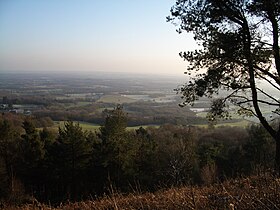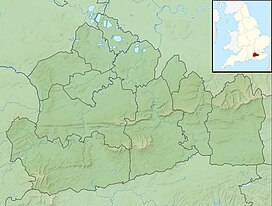Leith Hill
| Leith Hill | |
|---|---|
 |
|
| Highest point | |
| Elevation | 294 m (965 ft) |
| Prominence | 249 m (817 ft) |
| Listing | Marilyn,Hardy, County Top |
| Coordinates | 51°10′33″N 0°22′11″W / 51.17583°N 0.36972°WCoordinates: 51°10′33″N 0°22′11″W / 51.17583°N 0.36972°W |
| Geography | |
|
Leith Hill in Surrey
|
|
| Location | Surrey, England |
| Parent range | Greensand Ridge |
| OS grid | TQ139431 |
| Topo map | OS Landranger 187 |
Leith Hill is a wooded hill 7 km to the south west of Dorking, Surrey, England. It reaches 294 metres (965 ft) above sea level, the highest point on the Greensand Ridge, and is the second highest point in south-east England, after Walbury Hill near Hungerford, West Berkshire, 297 metres (974 ft) high.
It was possibly on the summit of Leith Hill in 851, that Æthelwulf of Wessex, father of Alfred the Great, defeated the Danes who were heading for Winchester, having sacked Canterbury and London.
The nearest railway station is Holmwood Station, 2 miles (3.2 km) to the east. This station is served by Southern trains on the Sutton & Mole Valley Line route.
The hill's first notable role in history was as a battlefield in the ninth century struggle between Saxons and Danes. In 851AD the Danes planned a full scale invasion, after raiding the country regularly for many years. The Danes invaded up the Thames and burnt Canterbury and then London. The next target was Winchester, but on their march towards Winchester they met the army of Ethelwulf, father of Alfred the Great. Ethelwulf, it seems, took up a position on the slopes of Leith Hill - an ancient mass grave found in 1882 seems to point to this area as the sight of battle (Stories of the Surrey Hills published by the Surrey Society). Ethelwulf was able to use position on high ground to win the huge battle that followed. This battle ended the Danes immediate prospects of conquering the whole of Britain.
On the summit of Leith Hill is an 18th-century Gothic tower. In 1765-6 Richard Hull of nearby Leith Hill Place built "Prospect House", later to become known as Leith Hill Tower, with the intention of raising the hill above 1,000 ft (305 m) above sea level. The tower is 19.5 metres (64 ft) high and consisted of two rooms "neatly furnished", with a Latin inscription above the door announcing that it had been built not only for his own pleasure, but also for the enjoyment of others. Hull provided visitors with prospect glasses, similar to a small telescope, through which to survey the extensive views towards London and the English Channel, each some 25 miles (40 km) away.
...
Wikipedia

